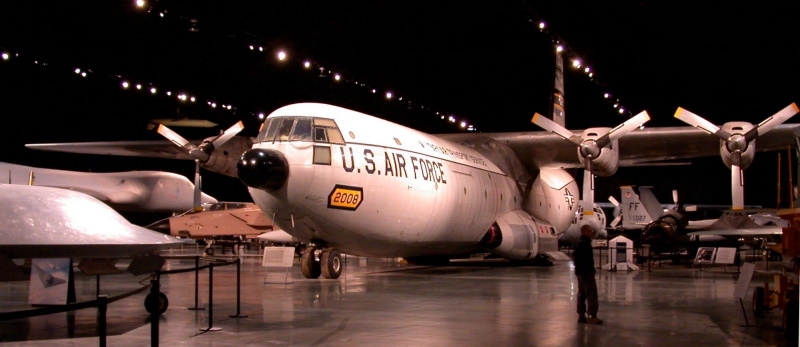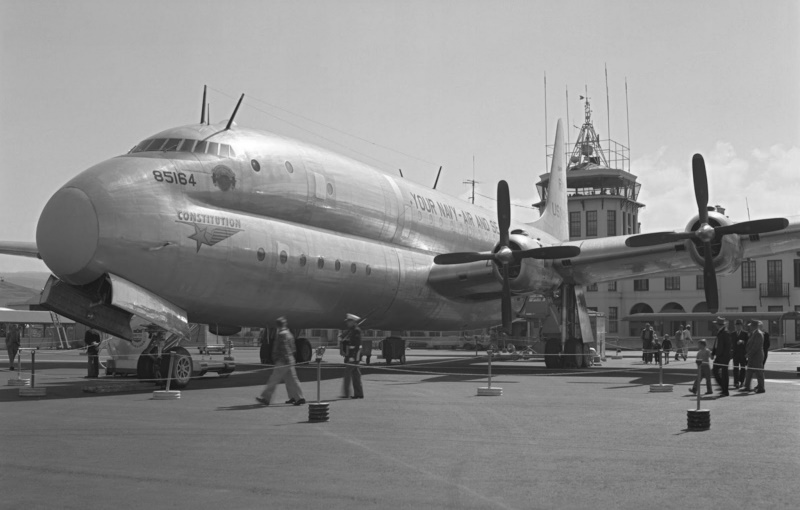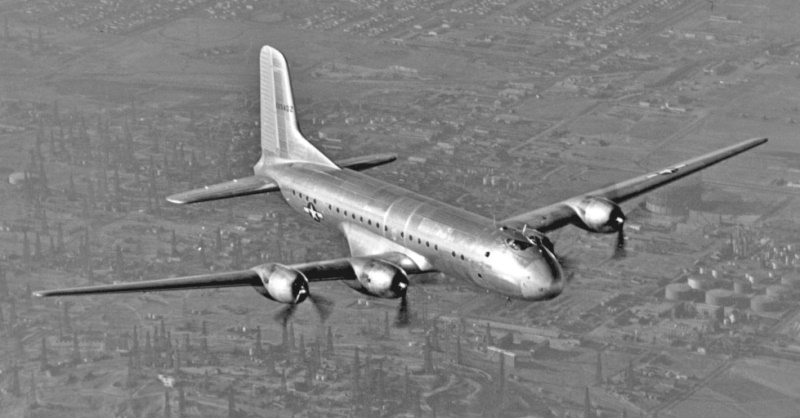
* After World War II, Douglas Aircraft provided a series of heavy transports for the US Air Force. While the Douglas "Globemaster" piston transport was only built in small numbers, it led to the improved "Globemaster II", which was an airlift workhorse well into the Vietnam War. Douglas also built a large turboprop transport, the "Cargomaster", that served in the 1960s. This document provides a history and description of the Globemaster, Globemaster II, and Cargomaster -- as well as of the comparable Lockheed "Constitution". A list of illustration credits is provided at the end.

* In early 1942, the Douglas Aircraft Company began design studies of a new heavy, long-range four engine transport aircraft, with the company designation of "Model 415", with an eye towards logistical support of operations in the Pacific theater. The work led to a formal US Army Air Forces (USAAF) contract in June 1942, specifying delivery of 50 of the transports. The aircraft was given the military designation of "C-74 Globemaster".
Although the design was as straightforward as possible to ensure that the aircraft could be put into production rapidly, the USAAF wanted Douglas to give higher priority to the A-26 Invader medium bomber, and the first C-74 wasn't rolled out until July 1945. It didn't perform its first flight until a few weeks after the end of the war, on 5 September 1945. At the time, it was the biggest land-based transport aircraft in the world.
The C-74 was basically a scaled-up DC-4 / C-54, with a low wing; four engines; conventional tail; and tricycle landing gear, with twin wheels on each unit. The engines were Pratt & Whitney (P&W) R-4360-27 Wasp Major 28-cylinder four-row air-cooled radials with 2,240 kW (3,000 HP) each, driving fully reversible Curtiss electric propellers to permit shorter landings and improved taxi maneuverability. The wings featured a sophisticated arrangement of flaps to permit shorter take-offs.
The C-74 had a crew of five, including copilot, pilot, radio operator, navigator, and flight engineer. Crew rest quarters were included for long-duration missions. Passageways were provided in the wing to permit the flight engineer to perform servicing and repairs while the machine was in flight. One unusual feature of initial-build Globemasters was that the pilot and copilot sat in individual "blister" or "bug-eye" type canopies to give them maximum all-round visibility. Since this scheme also complicated interactions between the two men, it was changed to a more conventional cockpit arrangement. Which aircraft had the bug-eye cockpit scheme and which did not; when it was implemented; and whether the conventional cockpit scheme was retrofitted to early aircraft is unclear.

The C-74 could carry 125 fully-equipped troops, 115 litter patients with their medical attendants, or up to 22,675 kilograms (50,000 pounds) of cargo. The cargo bay had twin hoists that could be moved on a rail up and down the bay. They could be used to drop a removeable belly section to ease loading of cargoes, reducing the need for specialized cargo handling equipment.
___________________________________________________________________
DOUGLAS C-74 GLOBEMASTER I:
___________________________________________________________________
wingspan:
52.82 meters (173 feet 3 inches)
wing_area:
233.18 sq_meters (2,510 sq_feet)
length:
37.86 meters (124 feet 2 inches)
height:
13.34 meters (43 feet 9 inches)
empty weight:
39,087 kilograms (86,172 pounds)
MTO weight:
78,018 kilograms (172,000 pounds)
max speed at altitude:
500 KPH (310 MPH / 270 KT)
cruise speed:
300 KPH (260 MPH / 225 KT)
service ceiling:
9,150 meters (30,000 feet)
range:
8,350 kilometers (7,200 MI / 6,260 NMI)
___________________________________________________________________
Douglas began discussions with Pan American World Airways in 1944 for sale of an airliner version of the C-74 for commercial service after the war. The "civilian" C-74 was to be designated the "DC-7", though Pan Am called it the "Clipper Type 9". Pan Am ordered 26 DC-7s in June 1944, but the price kept climbing and the order was canceled in October 1945. Similarly, although the USAAF contract had specified fifty C-74s, the order was cut back at the end of the war, and only fourteen C-74s were built. There was no "XC-74" prototype, or "YC-74" evaluation aircraft as such. One of the 14 built crashed in flight testing in August 1948, while another was a static test article that was tested to destruction. The small numbers of C-74s built meant that the aircraft's service was limited, but it gave the US Air Force (USAF, as the USAAF had become in 1947) experience with the operation and utilization of large transport aircraft.
The C-74 did achieve distinction during the Berlin Airlift in 1948. On 24 June of that year, the Soviets closed all land routes into the divided city of Berlin, Germany. The next day the USAF began Operation VITTLES, a massive airlift operation to keep the city supplied. One Globemaster, the 13th built, arrived at Frankfurt Rhein-Main Airfield on 14 August to join in the airlift. The C-74 proved a very useful asset in the effort, hauling large quantities of supplies and often performing several trips in a day. On 18 September, the C-74 flew a total of six round trips. The single C-74 was instrumental in helping build Tegel Airfield in the French sector of Berlin, hauling in heavy construction equipment that had been broken down into components for air delivery. The aircraft operated as part of the airlift for six weeks, but it was simply too heavy for the Berlin runways. There are stories that the Soviets complained that it might be used as a bomber because of its hoist well in the belly.
With the small number of C-74s in service, maintenance was an increasing headache as time went on and spares became harder to obtain, forcing the type's withdrawal from service. The last C-74 was finally retired from USAF service on 31 March 1956. Four ended up in civilian hands, operating into the 1960s. None have survived.
BACK_TO_TOP* The Air Force found the C-74 a very capable and useful aircraft, and began to consider acquiring much larger numbers of an improved version proposed by Douglas; the result was the "C-124 Globemaster II". The C-124 used the same wings, tail, and engines as the C-74, but featured a new and enlarged fuselage, as well as stronger landing gear to handle higher weights. It was powered by four P&W R-4360-63A radial engines, with 2,835 kW (3,800 HP) each.
The "YC-124" prototype, rebuilt from a C-74, performed its initial flight on 27 November 1949. The Globemaster II had "clamshell" doors in the nose with hydraulically-activated loading ramps. The cargo bay, which was 23.5 meters (77 feet) long, featured the overhead hoist and removeable belly section of the C-74. Each hoist had a load capacity of 7,250 kilograms (16,000 pounds). The C-124 could carry most Army field vehicles without requiring that they be dismantled; it could lift 33.560 kilograms (74,000 pounds) of cargo. Its double-decked cabin could also be fitted with 200 seats for troops, or with 123 litters for casualty evacuation. Flight crew numbered six.
The first operational C-124 was delivered in May 1950. A total of 204 "C-124As" was built, to be followed by 243 "C-124Cs". The C-124C featured uprated engines, an AN/APS-42 weather radar with a distinctive nose "thimble" radome, and wingtip-mounted combustion heaters to provide cabin heating and wing de-icing. The radar was retrofitted to most C-124As; some sources claim the heaters were as well, but others say not.
A turboprop-powered "KC-124B" tanker variant was considered, which emerged as a single "YC-124B" transport prototype that flew in 1954. The last of 448 Globemaster IIs was rolled out in May 1955. At the type's peak in 1963, there were 377 C-124s in service with 20 transport squadrons.

The C-124 provided valuable service in both the Korean and Vietnam Wars, though by the Vietnam era it was regarded as too slow. It was given a variety of nicknames by its crews, such as "Old Shakey", the "Shakemaster", the "Aluminum Cloud", or "Aluminum Overcast". The Globemaster II also performed many other duties, including Antarctic resupply missions, refugee evacuation, and disaster relief. The type was finally replaced by the Lockheed C-5 Galaxy in 1970.
___________________________________________________________________
DOUGLAS C-124 GLOBEMASTER II:
___________________________________________________________________
wingspan:
53.05 meters (174 feet)
wing area:
232.81 sq_meters (2,506 sq_feet)
length:
39.76 meters (130 feet 5 inches)
height:
14.74 meters (48 feet 4 inches)
empty weight:
45,890 kilograms (101,160 pounds)
MTO weight:
88,210 kilograms (194,500 pounds)
max speed at altitude:
485 KPH (300 MPH / 260 KT)
cruise speed:
370 KPH (230 MPH / 200 KT)
service ceiling:
5,610 meters (18,400 feet)
range with load:
4,675 kilometers (4,030 MI / 3,500 NMI)
___________________________________________________________________
BACK_TO_TOP
* The last of the big Douglas prop transports was the "C-133 Cargomaster", which was designed in response to the Air Force's 1952 "Logistic Carrier Support System SS402L" requirement, to carry outsize cargoes. Douglas began work on the type in early 1953, and was awarded a contract for twelve "C-133As" in 1954.
The first "C-133A" performed its initial flight on 23 April 1956. There was no formal prototype, with initial delivery to the USAF Military Air Transport Service (MATS) in August 1957. C-133As began international flight operations the next year, and quickly set several records for transport aircraft. By the time of the C-133A's operational introduction, the US was engaged in a frantic race to build ballistic missiles, and one of the primary roles of the C-133A turned out to be ferrying the missiles from the manufacturer to operational sites.

Conceptually, the C-133 looked much more like an elongated Lockheed C-130 Hercules than the C-74 or C-124. The Cargomaster had a high, straight wing, with main landing gear in fairings alongside the aircraft to ensure an unobstructed cargo bay. The cargo bay was 27.5 meters long and 3.7 meters high (90 feet by 12 feet), had a volume of 1,210 cubic meters (13,000 cubic feet), and was pressurized, heated, and ventilated.
Early production C-133As were powered by four P&W T34-P-3 turboprops with 4,476 kW (6,000 SHP) each, but later machines were fitted with T34-P-7WA turboprops with 4,849 kW (6,500 SHP) each and water-methanol injection for boost power. The aircraft had a crew of four, and could carry 50,000 kilograms (110,000 pounds) of cargo, or a fully-assembled Jupiter, Thor, or Atlas ballistic missile. 200 airline-type seats could be fitted for personnel hauling, at least in principle.
___________________________________________________________________
DOUGLAS C-133A CARGOMASTER:
___________________________________________________________________
wingspan:
54.78 meters (179 feet 8 inches)
wing area:
248.32 sq_meters (2,673 sq_feet)
length:
48 meters (157 feet 6 inches)
height:
14.7 meters (48 feet 3 inches)
empty weight:
54,550 kilograms (120,265 pounds)
MTO weight:
129,700 kilograms (286,000 pounds)
max speed at altitude:
580 KPH (360 MPH / 315 KT)
cruise speed:
525 KPH (325 MPH / 280 KT)
service ceiling:
9,150 meters (30,000 feet)
range with load:
6,480 kilometers (4,025 MI / 3,500 NMI)
___________________________________________________________________
The Cargomaster could be loaded through a side door on the right side of the aircraft, or a rear door. The first 32 C-133As had a two-section rear door that opened up and down, with the bottom section forming a loading ramp, while the last three had side-opening "clamshell" doors that extended the cargo bay by 90 centimeters (3 feet), allowing the aircraft to carry an assembled Titan missile. The 35 C-133As were followed by 15 "C-133Bs", with the clamshell doors and uprated Pratt & Whitney T34-P-9W turboprops providing 5,595 kW (7,500 HP) each. The last Cargomaster was rolled out in April 1961.
The C-133 served through the 1960s. It was a big aircraft that gave the Air Force a very useful heavy-lift capability, but it was not very successful. The turboprop engines were unreliable, leading to poor flight availability rates, and they also caused excessive vibration. It had a number of other problems as well, some of which led to disastrous accidents and groundings. It was never used as a troop transport, and it appears to have been generally disliked or even feared by anyone who had anything to do with it.
Airframe fatigue problems finally led to the Cargomaster's withdrawal from service in 1971, to the relief of all concerned. It was replaced by the C-5 Galaxy, which ironically would also suffer from premature fatigue problems. A handful of C-133s remained in commercial air cargo service for a few years after the type's withdrawal from military service. A number remain on display, but none are flying any more.
BACK_TO_TOP* As a footnote to the C-124 story, Lockheed developed a roughly comparable oversized four-piston transport, the "Constitution", though only two were made. It evolved out of a 1942 US Navy requirement for a large transport aircraft to follow the Navy's big flying boats. The aircraft would be pressurized and able to carry 7,900 kilograms (17,500 pounds) of cargo 8,000 kilometers (5,000 miles) at a cruising altitude of 7,600 meters (25,000 feet) and a speed greater than 400 KPH (250 MPH), with a buy of 50 aircraft projected. Pan Am was also involved in the work, since the aircraft seemed promising as a commercial airliner.
Initial flight of the "XR6O-1 Constitution" was on 9 November 1946, with the second following on 9 June 1948. The Constitution had some similarities to the earlier Lockheed Constellation airliner, being an all-metal aircraft with retractable tricycle landing and a low wing with four piston engines. It was, of course, much bigger, with a double deck -- featuring a "figure 8" or "double bubble" cross-section -- and a conventional tail assembly.

The engines of the Constitutions were originally P&W Wasp Major R-4360-18 radials with 2,240 kW (3,000 HP) each, driving four-bladed variable-pitch paddle propellers. They weren't powerful enough, so they were upgraded to R-4360-22-W engines with water-methanol injection for power boost, raising the power output to 2,610 kW (3,500 HP). There were also experiments with rocket-assisted take-off (RATO), using six RATO boosters under the wings close to the fuselage, to reduce the take-off field length.
___________________________________________________________________
LOCKHEED R60/V CONSTELLATION:
___________________________________________________________________
wingspan:
57.6 meters (189 feet 1 inch)
wing area:
335.4 sq_meters (3,610 sq_feet)
length:
47.6 meters (156 feet 1 inch)
height:
15.4 meters (50 feet 4 inches)
empty weight:
51,610 kilograms (113,780 pounds)
operating weigh:
72,600 kilograms (160,000 pounds)
MTO weight:
83,460 kilograms (184,000 pounds)
max speed at altitude:
490 KPH (300 MPH / 265 KT)
cruise speed:
420 KPH (260 MPH / 230 KT)
service ceiling:
8,700 meters (28,600 feet)
range:
8,670 kilometers (5,390 MI / 4,680 NMI)
___________________________________________________________________
The nose gear had twin wheels and retracted forward, while each main gear assembly had four wheels in a 2x2 bogey arrangement, retracting inward from the wings towards the fuselage. The Constitution carried 12 crew and 92 passengers on the upper deck; the lower deck was intended for cargo carriage, though it could be fitted with 72 passenger seats. The two were delivered to the US Navy in 1949, operating under the designation of "R6O-1" to fly the California-Hawaii shuttle. In 1950, their designation was changed to "R6V-1".
The Constitutions proved impractical, being expensive to operate and underpowered. There was consideration of a turboprop-powered version using the Wright T35 Typhoon engine, with 4,450 kW (6,090 ESHP), but the Typhoon program was a failure and it didn't happen. No more Constitutions were built. The two machines were retired in 1953, to be sold off to commercial buyers, with one ending up in Las Vegas, Nevada, as a display, to be ultimately scrapped. The other ended in Florida, with nobody having a real plan of what to do with it, until it was finally scrapped as well. The R6V is said to have been the biggest fixed-wing aircraft ever flown by the US Navy, but ended up with no other distinction.
BACK_TO_TOP* This document began life as a set of notes from materials found on THE AVIATION ZONE and THE GLOBEMASTER TRIBUTE PAGE websites. More formal sources include:
* Illustrations details:

* Revision history:
v1.0.0 / 01 feb 02 v1.0.1 / 01 feb 04 / Review & polish. v1.0.2 / 01 mar 05 / Review & polish. v1.0.3 / 01 mar 07 / Review & polish. v1.0.4 / 01 mar 09 / Review & polish. v1.0.5 / 01 feb 11 / Review & polish. v1.0.6 / 01 jan 13 / Review & polish. v1.0.7 / 01 feb 14 / Review & polish. v1.0.8 / 01 jan 16 / Review & polish. v1.0.9 / 01 dec 17 / Review & polish. v1.1.0 / 01 nov 19 / Review & polish. v1.1.1 / 01 sep 21 / Review & polish. v1.2.0 / 01 dec 22 / Added R6V Constitution. v1.2.1 / 01 nov 24 / Review & polish.BACK_TO_TOP
